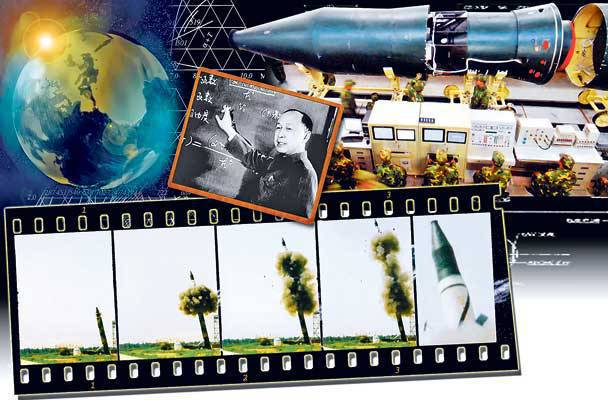"Counterattack" and "Pioneer" to protect the Middle Kingdom

Over the past few years, Russian statesmen, politicians and experts have exhausted many tons of paper, said hundreds of thousands of words about the deployment of American missile defense. Meanwhile, developments in the field of missile defense have been actively pursued (and perhaps are being conducted) not only in the United States, but also in the People’s Republic of China, and not without result.
45 years ago - February 23, the government’s Commission on Defense Science, Technology, and Industry of the People’s Republic of China adopted a phased and detailed program for the creation of a national missile defense system, which was given the code name “1966 Project”. The Chinese, inclined to conspiracy, in this case proceeded from the so-called 640 directive - the governing wish expressed a couple of years earlier by Mao Zedong in a conversation with Qiang Xueshen, the founder of the PRC rocket and space program.
Overtake Moscow and Washington
The great helmsman, to whom the intelligence services of the Celestial Empire brought information about work on the problem of strategic missile defense in America and the Soviet Union, then said about the need to by all means catch up with the “imperialists” and “revisionists” in this area. By that time, work on the A-35 anti-missile system was in full swing in the USSR, and in the USA the Nike-Zeus trans-atmospheric interception system was already adopted and a new Nike-X PRO system was being developed. The territory of China, which at that time seriously damaged relations with Moscow, came under the gun not only of the American, but also of the Soviet nuclear missile weaponsFirst of all, medium-range ballistic missiles - Р-5М, Р-12 and Р-14.
Dr. Qian and his subordinate colleagues enthusiastically got down to business. Despite the growing momentum of the Cultural Revolution and the enormous resources directed by Beijing to solving the primary defense task of deploying the production of nuclear weapons, the Chinese anti-missile program received a high state priority. Several numbered ministries of machine building, the Academy of Sciences of the People's Republic of China, the Second Artillery (Rocket Forces) and the “20 Base”, a rocket test range now better known as the Shuangchenzi space center, from which the first Chinese manned spacecraft launched into orbit .
The “640 project” envisaged the creation of a family of “Fanxi” anti-missile missiles (“Counterattack”), an anti-missile cannon (!) “Xinfeng” (“Pioneer”) and a missile early warning system radar station. In addition, it was decided to speed up the work on the construction of a ground-based test complex for anti-missile missiles and to begin the development of nuclear combat units for them.

The most active phase of the implementation of the “640 project” occurred in the 70s. During this period, work on it was conducted under the auspices of the Academy of anti-missile and anti-space defense - it was so renamed by the personal order of Prime Minister Zhou Enlai Second Academy of the Seventh Ministry of Mechanical Engineering - an analogue of the Soviet Minsredmash responsible for rocket production. By the way, the name “Second Artillery” for the rocket troops of the People’s Liberation Army of China also came up with Zhou Enlai.
The approach of the Chinese to the creation of the Fanxi antimissile mainly conformed to the philosophy implemented in the American Nike-X missile defense system, the combat means of which were Spartan long-range interceptor missile intercept and Sprint anti-missile anti-missile. As is known, the Sprint was intended to “finish off” the head parts of intercontinental ballistic missiles, which would manage to break through to the protected object, avoiding defeat in outer space with the main anti-missile “Spartan”.
Moreover, it was not only about the fundamental philosophy of the project, but also about direct constructive borrowings, which were resorted to by Chinese engineers, whose random congeniality is hard to believe. But it is well known that Qiang Xuesen as a talented specialist was held in the USA, from where he arrived at historical homeland already an venerable scientist in 1955, having in the asset extensive contacts in aircraft science and industry in America. And after his repatriation, the PRC intelligence could very well use these connections, although the Chinese Korolev was subjected to restrictions in the United States during the hunt for “communist witches” there.
On the other hand, it is not at all possible that while constructing their anti-missiles, the Chinese carefully studied the open Western military technical literature, including the popular one, where the Saynthel and Safeguard systems of Nike-X and its further clones were described in details completely unacceptable, say, for the press of the USSR. And if China had at its disposal documentation for the Soviet anti-missile system А-35, he most likely would have tried to develop something similar to her. After all, the Chinese created their own versions of the P-5M and P-12 ballistic missiles (and sent to the Soviet Union) thanks to Nikita Sergeevich Khrushchev, who ordered the transfer of technical documentation for these products to the domestic defense industry.
"Sprint" in Chinese
However, you can assume anything, but the fact remains: the Chinese low and medium altitude missile "Fanxi 1" outwardly turned out to be almost a double of the American Sprint. The first “Counterattack”, like the Sprint, was a two-stage hypersonic rocket. It had to be equipped with a semi-active radar homing head.
True, unlike the fully solid-fuel Sprint, the first stage of the Fanxi-1 had a liquid-propellant rocket engine. In addition - and the Chinese and American systems differed in this - for the near-line interception (here the Americans intended to use only the Sprint missiles), the People's Republic of China also developed the low-altitude Fancy 2 rocket. And the analogue of "Spartan" was to become the anti-missile of the inter-atmospheric interception "Fanxi-3". For Chinese antimissiles, as well as American, nuclear equipment was provided.
It is believed that the Chinese brought to the stage of flight tests only reduced prototypes of the Fanxi-2 rocket launched in 1971 – 1972, and the throwing mass-dimensional models of the Fanxi-1 rocket, the first launches of which took place in the 1979. “Fanxi-3” never saw the sky, much less the space heights - its development was curtailed in the 1977 year. The creation of "Fanxi 2" stopped four years earlier - this element of the missile defense was ultimately considered redundant.
The PLA command, inspired by the first flights of experimental anti-missiles, without waiting for the completion of the work on the Fanxi-3, proposed to deploy a limited missile defense system based on the Fanxi-1 to cover Beijing.
As for the Xinfun antimissile supergun, this ridiculous miracle of Chinese engineering thought was born in the 210 institute, which was under the auspices of the Pro-PKO Academy. The Pioneer project (the “640-2 project”) was submitted to the PRC’s military-political leadership in the year 1967. It turned out to be a real monster, whose 420-millimeter barrel was intended for firing unguided active-reactive nuclear shells with a mass of 160 kilograms against enemy warheads entering the dense layers of the atmosphere. The stationary artillery mount weighed 155 tons.
They even passed the test of "Sinfyna". At the first of them the testing of the 140-millimeter smooth-bore model of the gun took place. From it released 18-kilogram shells, beat at a distance 74 kilometer. They worked with Pioneer until 1977 of the year, and in 1980, work on all of the strategic missile defense weapons in the framework of the “640 project” was finally stopped. This decision was made by the “father” of Chinese economic reforms, Deng Xiaoping, who considered that the program, the prospects for the successful completion of which are far from obvious, is extremely burdensome for the country's budget. The Treaty on the Limitation of Anti-Ballistic Missile Systems, concluded in the 1972 year between the USSR and the USA, played a significant role in this - after all, China was trying to catch up with them.
Be that as it may, the “640 project” has proven to be very useful in strengthening the defense capacity of the PRC. The work carried out within its framework to create appropriate radar systems allowed the Chinese to acquire ground stations for tracking space objects and an early warning of a rocket attack, however, limited in their capabilities in comparison with similar stations in the USSR and the USA. Such radars, in particular, include radar stations "7010" and "110", which formed the basis of the national early warning system of the Middle Kingdom.
Wind in orbit
Today, China, which undoubtedly has the ability to create "classic" ground-based anti-missile systems (at least at the technological level of 80's superpowers), has turned its attention to space. The most promising business there seems to be the mastering of anti-satellite technologies. The level of scientific and technical potential of the People's Republic of China in this area was demonstrated in January 2007, when the Chinese AES fighter jet launched into the polar orbit altitude 853 kilometer destroyed its Chinese meteorological satellite Fyn Yun-1 (Wind and Clouds-1) . The antisatellite struck the "meteorologist" in a kinetic way - a direct hit on him.
To launch the anti-satellite, a promising launch vehicle of the “Kitautozhe” type (“Researcher”) was used. This is a family of Chinese solid-fuel space rockets developed on the basis of the first and second stages of the intercontinental ballistic missile Dunfeng-31 (East Wind-31) and the new third stage, which was tested in 2001 year. Such carriers are capable of delivering a payload of up to 300 – 400 kilograms to the polar orbit.
Judging by some reports, "Kaitaukozhe" can be launched within 20 hours after receiving an order to start not only from a stationary launch pad, but also from a self-propelled launcher. The rocket, which threw the first Chinese satellite-killer into space, launched from an unidentified area near the Xichang cosmodrome (“27 base”) - probably, just from a mobile launcher
Information